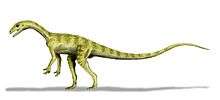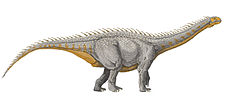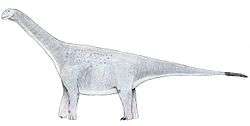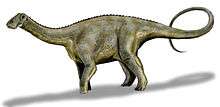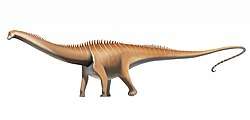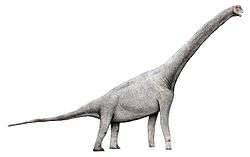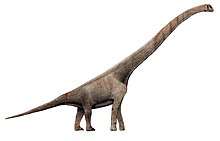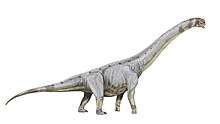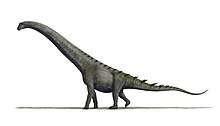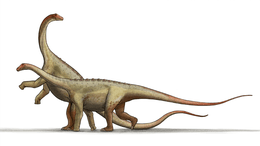Cedarosaurus
Cedarosaurus (meaning "Cedar lizard" - named after the Cedar Mountain Formation, in which it was discovered) was a nasal-crested macronarian dinosaur genus from the Early Cretaceous Period (Barremian). It was a sauropod which lived in what is now Utah. It was first described by Tidwell, Carpenter and Brooks in 1999.[1]
| Cedarosaurus | |
|---|---|
 | |
| Life restoration | |
| Scientific classification | |
| Kingdom: | Animalia |
| Phylum: | Chordata |
| Clade: | Dinosauria |
| Clade: | Saurischia |
| Suborder: | †Sauropodomorpha |
| Clade: | †Sauropoda |
| Family: | †Brachiosauridae |
| Genus: | †Cedarosaurus Tidwell et al., 1999 |
| Species: | †C. weiskopfae |
| Binomial name | |
| †Cedarosaurus weiskopfae Tidwell et al., 1999 | |
It shows similarities to the brachiosaurid Eucamerotus from the Wessex Formation of southern England, as well as to Brachiosaurus from the Morrison Formation.
Description

Cedarosaurus had a more gracile ulna and radius than its relative Venenosaurus.[2] The ratio of the radius' least circumference to its length is .31 in Cedarosaurus. Metatarsal II is more gracile in Cedarosaurus.[2]
Its middle tail vertebrae's neural spines are angled anteriorly when the vertebrae are aligned.[3] These vertebrae resemble those of Gondwanatitan, Venenosaurus, and Aeolosaurus.[3]
The related Venenosaurus had unusual lateral fossae, which looked like deep depressions in the outside walls of the vertebral centra.[4] Some fossae are divided into two chambers by a ridge inside the depression.[4] In most sauropods the fossae would form pneumatic openings leading to the interior of the centrum, rather than just being a depression.[4] Less well-developed, but similar fossae are known from Cedarosaurus itself.[4]
Palaeobiology
In 2001 Frank Sanders, Kim Manley, and Kenneth Carpenter published a study on 115 gastroliths discovered in association with a Cedarosaurus specimen.[5] The stones were identified as gastroliths on the basis of their tight spatial distribution, partial matrix support, and an edge-on orientation indicative of their being deposited while the carcass still had soft tissue.[5] Their high surface reflectance values are consistent with other known dinosaur gastroliths.[5] Nearly all of the Cedarosaurus gastroliths were found within a .06 m volume of space in the gut region of the skeleton.[6]
The total mass of the gastroliths themselves was 7 kilograms (15 lb).[7] Most were less than 10 millilitres (0.35 imp fl oz; 0.34 US fl oz) in volume.[8] The least massive clast was .1 grams (0.0035 oz) and the most was 715 grams (25.2 oz), with most of them being toward the smaller end of that range.[8] The clasts tended to be close to spherical in shape, although the largest specimens were also the most irregular.[8] The largest gastroliths contributed the most to the total surface area of the set.[9] Some gastroliths were so large and irregularly shaped that they may have been difficult to swallow.[9] The gastroliths were mostly composed of chert, with some sandstone, siltstone, and quartzite clasts also included.[10] Some of the chert clasts actually contained fossils.[10]
Since some of the most irregular gastroliths are also the largest, it is unlikely that they were ingested by accident.[9] Cedarosaurus may have found irregular clasts to be attractive potential gastroliths or was not selective about shape.[9] The clasts were generally of dull coloration, suggesting that color was not a major factor for the sauropod's decision making.[5] The high surface area to volume ratio of the largest clasts suggests that the gastroliths may have broken down ingested plant material by grinding or crushing it[11] The sandstone clasts tended to be fragile and some broke in the process of collection.[10] The sandstone gastroliths may have been rendered fragile after deposition by loss of cement caused by the external chemical environment.[12] If the clasts had been that fragile while the animal was alive, they probably rolled and tumbled in the digestive tract.[11] If they were more robust, they could have served as part of a ball-mill system.[11]
Footnotes
- Tidwell, et al. (1999).
- "Discussion," Tidwell, Carpenter, and Meyer (2001). Page 157.
- "Caudal Vertebrae," Tidwell, Carpenter, and Meyer (2001). Page 146.
- "Caudal Vertebrae," Tidwell, Carpenter, and Meyer (2001). Page 147.
- "Abstract," in Sanders et al. (2001). Pg. 166.
- "Occurrence in Cedarosaurus," in Sanders et al. (2001). Pg. 169.
- "Table 12.2," in Sanders et al. (2001). Pg. 171.
- "Description," in Sanders et al. (2001). Pg. 172.
- "Description," in Sanders et al. (2001). Pg. 174.
- "Description," in Sanders et al. (2001). Pg. 176.
- "Description," in Sanders et al. (2001). Pg. 177.
- "Conclusion," in Sanders et al. (2001). Pg. 177.
References
- Sanders, F.; Manley, K.; Carpenter, K. (2001). "Gastroliths from the Lower Cretaceous sauropod Cedarosaurus weiskopfae". In Tanke, Darren; Carpenter, Ken (eds.). Mesozoic Vertebrate Life: New Research Inspired by the Paleontology of Philip J. Currie. Indiana University Press. pp. 166–180. ISBN 0-253-33907-3.
- Tidwell, V., Carpenter, K. and Brooks, W. (1999). "New sauropod from the Lower Cretaceous of Utah, USA". Oryctos 2: 21-37
- Tidwell, V., Carpenter, K. & Meyer, S. 2001. New Titanosauriform (Sauropoda) from the Poison Strip Member of the Cedar Mountain Formation (Lower Cretaceous), Utah. In: Mesozoic Vertebrate Life. D. H. Tanke & K. Carpenter (eds.). Indiana University Press, Eds. D.H. Tanke & K. Carpenter. Indiana University Press. 139-165.
